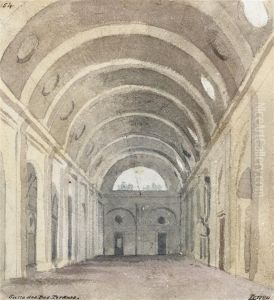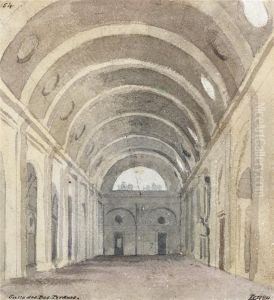Benjamin Ferrey Paintings
Benjamin Ferrey was a notable British architect who played a significant role in the Gothic Revival movement during the 19th century. Born in Christchurch, Hampshire, on May 31, 1810, Ferrey was the son of Benjamin Ferrey Snr, who was a draper. He was educated at Wimborne Grammar School in Dorset and later articled under the influential architect Augustus Charles Pugin, father of the more famous Augustus Welby Northmore Pugin, one of the leading figures of the Gothic Revival. This connection with the Pugin family would have a lasting influence on Ferrey's architectural style.
Ferrey began his professional career in the early 1830s. In 1834, he won a silver medal from the Institute of British Architects for his design of a Gothic church. His career was significantly boosted by his appointment as Diocesan Architect for Bath and Wells, which gave him numerous commissions for church restorations and new buildings in the region. Throughout his career, Ferrey designed or restored over 50 churches, and his work was characterized by the use of medieval Gothic styles adapted to the needs of his time.
In addition to churches, Ferrey was involved in the design and restoration of several significant buildings, including schools, houses, and institutions. He was an advocate for the conservation of ancient buildings and served on various committees dedicated to this cause. His notable works include the restoration of the chapter house of Wells Cathedral, the design of the seaside town of Bournemouth, and contributions to the design of the Houses of Parliament alongside Charles Barry and A.W.N. Pugin.
Benjamin Ferrey was also a founding member of the Royal Institute of British Architects (RIBA) and was twice its vice-president. He published several books on architecture, including 'Recollections of A. N. Welby Pugin' and 'An Ancient Timber House in the Parish of St. Helen, Bishopsgate'. His legacy includes a large collection of drawings and designs that provide insight into the Gothic Revival architecture of the Victorian era.
Ferrey passed away on July 22, 1880, leaving behind a rich architectural heritage. His contributions to the field of architecture and his role in the Gothic Revival movement have been recognized by scholars and are still studied today. His work continues to be appreciated for its historical significance and craftsmanship.

